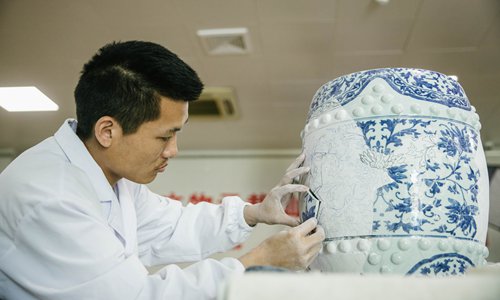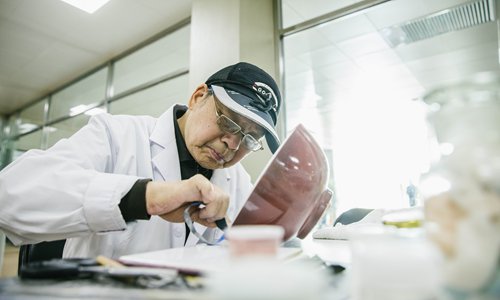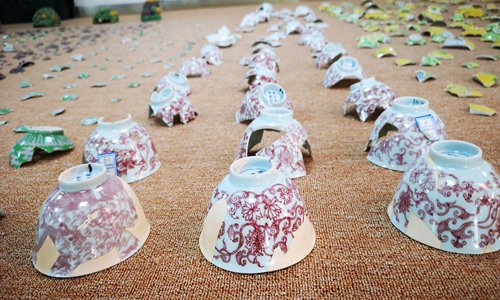HOME >> CHINA
Yuanmingyuan Park repairs large-scale damaged porcelain relics for the first time
By Zhang Dan Source:Global Times Published: 2019/5/22 17:58:40

The blue and white porcelain stool, or "xiudun," is being repaired from the broken 132 pieces unearthed in Yuanmingyuan Park. Photo: Li Hao/GT
It was hard to imagine what kind of blue and white porcelain could be made up of 132 potsherds until Beijing's Old Summer Palace, or Yuanmingyuan Park, started its "Restoring 1860" project recently.
This is the first time the royal garden of the Qing Dynasty (1644-1911) to carry out a large-scale restoration work of porcelain relics unearthed in the garden.
Located in northwestern Beijing, Yuanmingyuan Park boasts an extensive collection of architecture and exquisite historical relics which were unfortunately burned and ransacked by British and French troops, while the Anglo-French expedition force invaded China during the Second Opium War in 1860.
Restoration work of the first batch of relics - a snuff bottle, a stool, two bowls and two pieces of glazed tiles - is nearly finished.
Chen Hui, head of the Archaeology Department of Yuanmingyuan Administration, told the Global Times that in Chinese language the character for "restoration" and "revival" are the same phrase.
"We hope that the 'Restoring 1860' project can help restore the glory of mankind that was buried from history and show them to people. It is a representation of the revival of Yuanmingyuan Park and even the revival of China," Chen said.
Hard process
Among the six damaged historical relics, the blue and white porcelain stool, or "xiudun" is the most difficult to repair, according to Wang Mian, a Chinese ceramics repair expert.
"We have spent more than 20 days on the stool because it was shattered into 132 pieces. The tiniest piece was smaller than a fingernail. In addition, many pieces are disconnected," Wang told the Global Times.
However, thanks to pattern symmetry of Chinese antiques, experts can restore the artifact according to the other side's pattern, he said.
The 79-year-old has been working in the field for 53 years. The motivation for him to restore the relics unearthed in Yuanmingyuan Park is his aspiration to bring new life to the damaged cultural relics that were official ware - "the most delicate and the best" porcelain, and to show them to the people.
"Nobody knew what it used to look like when the 132 damaged pieces were left there. What was its pattern? How large is the ware? Nobody knew it before it was restored," said Wang.

Chinese ceramics repair expert, Wang Mian, repairs a red glaze bowl used in the Qing Dynasty (1644-1911). Photo: Li Hao/GT
He said that the 132 pieces were ineffective until people saw what the relics looked like.
The stool was actually placed at "Tantandangdang" - an area for the emperor to watch goldfish at Yuanmingyuan Park. Chen noted it was used by an unknown royal family member during the middle term of the Qing Dynasty.
However, "according to memoirs from the Anglo-French expedition force, they had taken whatever they could and broken what they couldn't." She said that the park has unearthed more than 100,000 damaged pieces of porcelain since 1988 when the park started to protect the ruins.
Another big challenge for the park to restore ancient treasures is that the damaged parts are scattered around every corner within and outside Beijing.
"It was not like we broke a bowl at home where you can find all of the fragments. In the past, people might pick up a porcelain piece in the park, assume it was useless and throw it into the river," Chen said, adding that many pieces are still missing, resulting in failure to restore some relics.
Even though the park finds it hard to predict how many cultural relics the project can restore, it will continue the project and show the six repaired relics to the public as soon as possible.
The park also appreciates the assistance in receiving returned lost relics from regular people and international independent people or scholars who are interested in Chinese culture.
Restore or not
Asking what kind of cultural relics could be restored, Wang told the Global Times that it depends on the ware and its situation.
"The beauty of some cultural relics lies in its incompletion, such as the Venus de Milo, one of the most famous works of ancient Greek sculptures, in Paris at the Louvre Museum. But then again, what if Venus lost her leg, which hinders her ability to stand up, would people still think she is beautiful?"
Wang said every cultural relic has its own characteristics and there is no need to restore it to the "perfect" level.

Yuanmingyuan Park starts the "Restoring 1860" project in late April to repair damaged porcelain on a large scale. Photo: Courtesy of Yuanmingyuan Administration
He also noted the attitude towards relic restoration in China is different from that of the Western world. "Westerners do not fully restore the relics - they believe the incomplete ones are good.
However, in the field of China's antiques estimator, people hope the preservation of relics could stay complete," Wang noted.
But for porcelain, restoration could bring better preservation, in case the ceramic relics are broken into more pieces. If more pieces of a cultural relic are found in the future, we can add them to the already partially restored relic, he said.
Talking about whether the Notre Dame cathedral in Paris which was engulfed in fire on April 15 could be restored, Wang said as long as time and manpower are put into the restoration work, it will not be a problem for the French to restore it according to the architectural drawings.
"But restored buildings and relics are new. Those ruined will never come back," he noted.
Newspaper headline: Restoring 1860
Posted in: IN-DEPTH,CHINA FOCUS